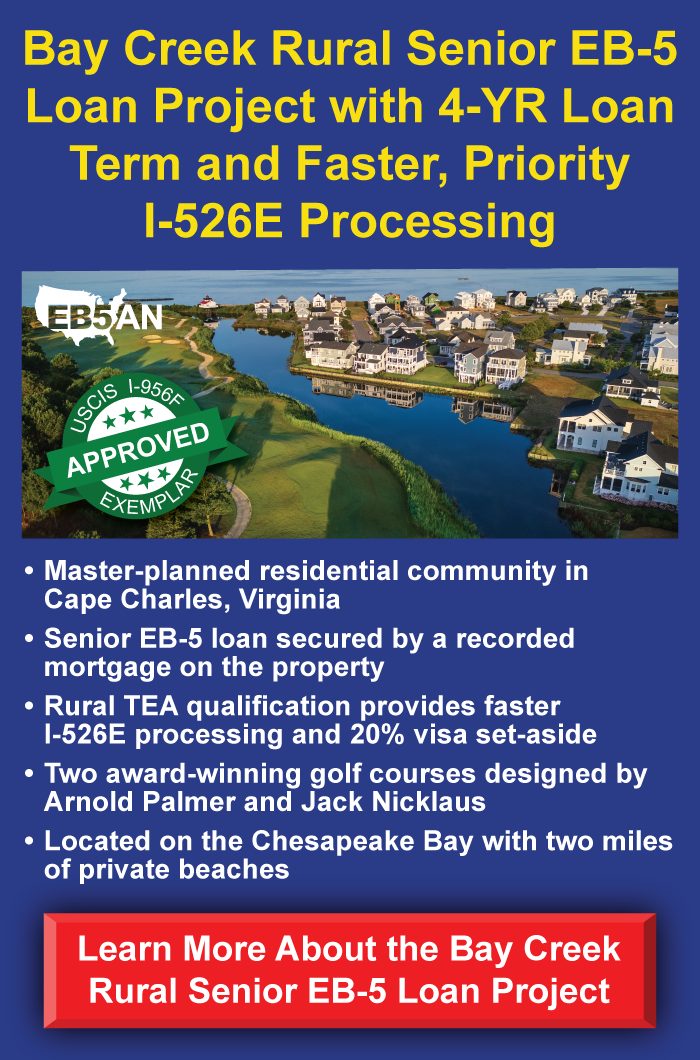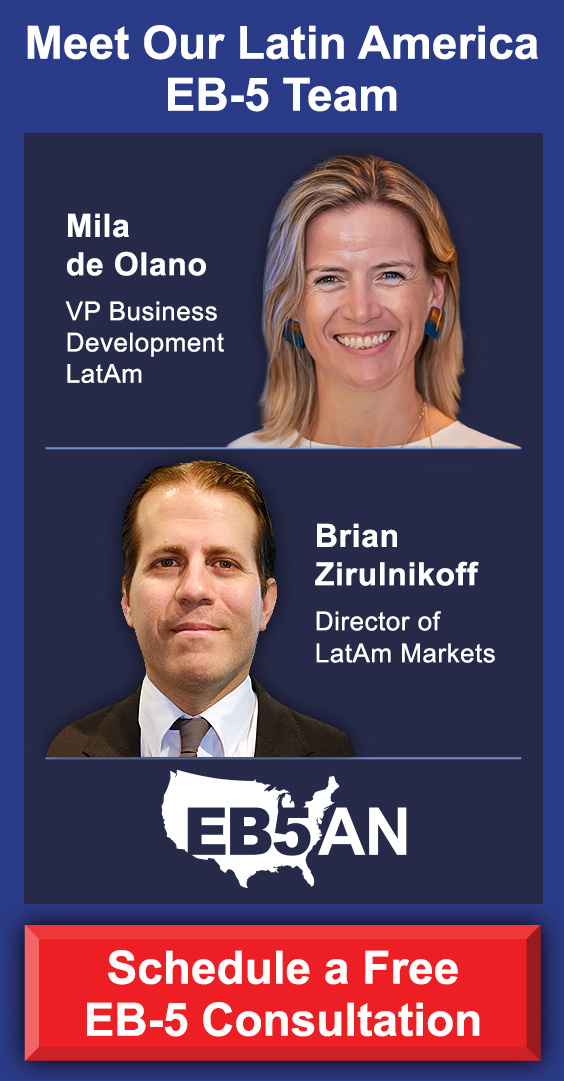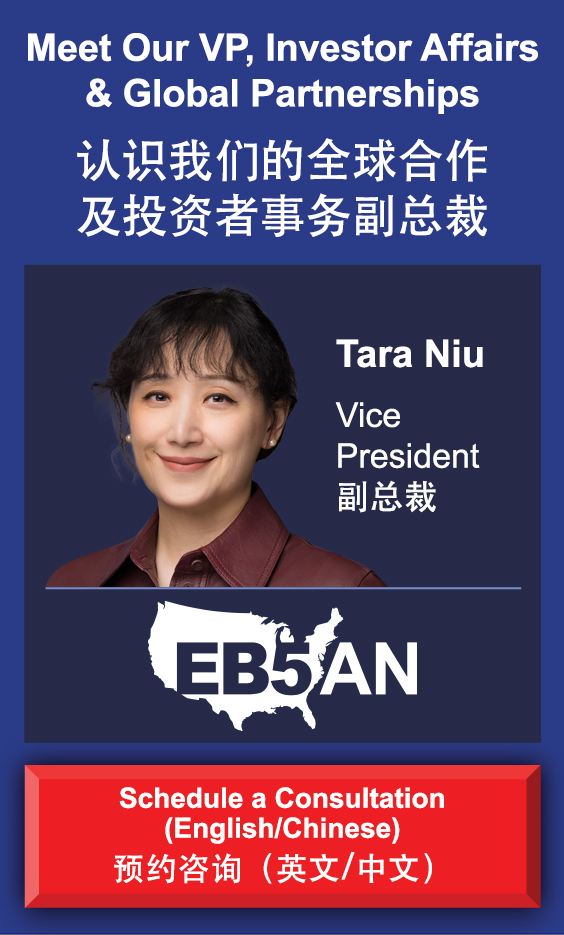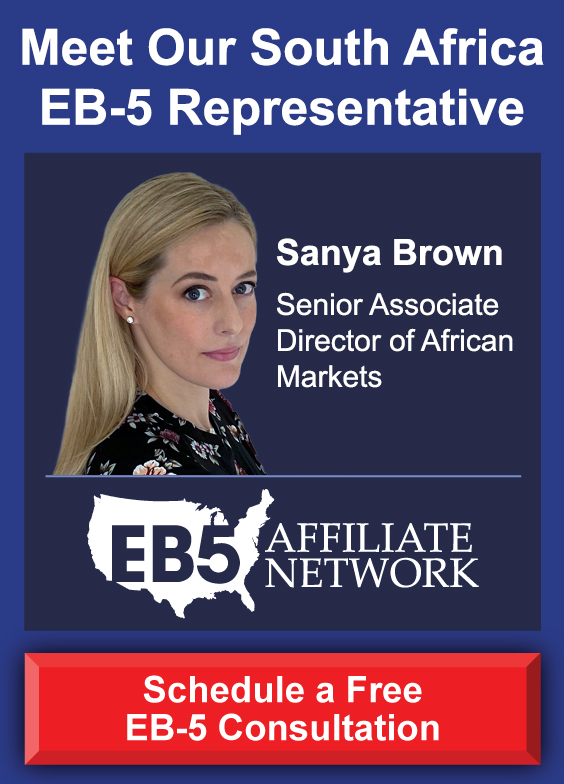Select Highlights of the Interview with Prakash from India
EB-5 Investor in the EB5AN Rocky River Rural EB-5 Project
- “EB-5 was the only other option that I could think of which has the current status for Indians as well in the rural and urban TEA. So that became very attractive”
- “There is very little red tape with the EB5AN to get all the information about the project or the offering materials and then the subscription documents and all that. So the transparency was great.”
- “I was looking for something with a low risk and higher probability to get the EAD and the AP. So with all the news that you see with the new administration, all the things that are happening created some sense of urgency in me to get this EAD and AP […] The Rocky River project is of a lower risk and it’s also current for India.”
Full Interview with Prakash from India
EB-5 Investor in the EB5AN Rocky River Rural EB-5 Project
Transcript of the Interview with Prakash from India
Introduction and Background
Yeah. Thanks, Sam. Thanks for having me here. Yeah, I’m Prakash Yaji from the southern part of India, closer to Bangalore. I’ve been in the U.S. for the last eight years. I’ve been on L-1, H-1B, and my wife is also on L-2 and H-4, etc. It’s been eight years of journey of this backlog. And then we started evaluating some of these options, because of being on H-1B and the EB-2 priority date is somewhere in like mid-2018. The wait time and the backlog was pretty long. And then we also have a U.S.-born daughter, so we didn’t want to be in the worry of the visa for so long. Yeah.
Attorney Selection and Documentation Process
Yeah. So when I started this process, it was like learning about two things. One is the program itself and then how would the regional center work and how the whole legal process would work and all that. So from the regional center and process-wise for me, the EB5AN “start here” guide, the process about the whole EB-5 flow chart, I kind of like printed it out and started looking at it once in a while. So that kind of gave me an overview.
And then from the attorney perspective, I spoke to three different attorneys. They were all good with respect to mostly like pros I could see. They were all having their own niche areas of expertise. Some were working with more of Indian kind of backgrounds, some were from the U.S. background, etc. So they were all good. It was a tough call. I ended up choosing Darren Silver’s team. They were pretty good. They seemed to have bandwidth, and pricing wise, they were good value for the money. And yeah, I ended up choosing Darren Silver’s team.
Yeah. From the experience perspective, it was pretty good. They sent me all the document checklists, what to collect and then what all I need to upload. And then they went through different source of funds plans. And then they simplified my overall portfolio. I was initially planning to choose the most optimal set of funds so that I don’t need to liquidate most of my stocks, but then that led to too many source of funds, like four or five different sources, because I was trying to optimize the stock sales. But that would create a risk, because you have too many source of funds to evaluate. So they came up with a simplified process, like what makes sense to be liquidated. So that recommendation process and everything was great. Yeah, hopefully that doesn’t raise any red flags.
And then time-wise, once I hired them, it probably took me around four to five weeks just to get the source of funds finalized, all the documents finalized. It took me almost a week to download all the documents. I downloaded all the pay slips and bank statements even before I selected the attorney because I knew those are some of the things that are necessary. But then I had to document so many other things, like all the different bank statements, all of my rental property details, HELOCs, etc., investment brokerage. So I downloaded all of those funds and the statements, and then I uploaded them.
They took almost another week or so, probably like two weeks, to review all of that and then came up with a simplified next set of questions or simplification recommendations.
And that’s when I started working with Syed Ali and Anibal from their team more closely. And it probably took another two to three different weeks to fully finalize on the source of funds, like which account, how much money I should liquidate, which account it should be deposited to so that there’s not too many transactions going in and out. It keeps everything simpler.
Yeah. So roughly around four to five overall timeline, four to five weeks of overall timeline.
Yeah. I would recommend them to understand their own unique situation and hire the attorney that is more optimal, because I’ve seen a lot of people hire Indian-origin attorneys if they have more Indian funds and so on and so forth, like different countries depending on their background. That’s one thing I’ve seen people do.
And also, you need to understand if the attorneys have the bandwidth to take on your cases. Because of this retrogression news and everything, I think there’s a lot of influx of clients for them. So you need to make sure that they’re not oversubscribed to support you. So because of that, you may have to confirm that.
But yeah. Mostly, I’ve seen a positive experience when I connect to these attorneys. And yeah, the pricing is also … You can probably talk to different people and see if that’s within your budget or not.
Regional Center and Project Evaluation
Yeah. So with the EB5AN and Kolter, how I decided to go with that … So I’ll first answer that one. So with EB5AN, I could read through all the different offerings and the project materials and everything online. So EB5AN had different types of projects as well, some with the hotel or a resort one and then some with urban TEA constructions. And this Rocky River is the rural TEA, single-family housing kind of project. All these are somewhat real estate development projects, which I understand a little bit. I have some experience in investing in single-family residences, but I never developed anything. But the offering materials sounded somewhat familiar.
Many other regional centers have different types of project that doesn’t resonate with my experience. That’s one side of the story.
And then I could read through all the different documentation, project materials, read through Kolter, the feedback about the developer. I even chatted with their chatbot to see how they respond to certain … the home sales experiences and everything. Everything felt very positive from Kolter to EB5AN and all that. So that whole online documentation and access to the information online made me comfortable to decide to go with the EB5AN and Kolter project. Yeah. And … yeah.
The most important factor, I was looking for something with a low risk and higher probability to get the EAD and the AP. I have a stable H-1B visa with the I-140 annual option and all that, but then that doesn’t come with an EAD or AP. So with all the news that you see with the new administration, all the things that are happening created some sense of urgency in me to get this EAD and AP just to stabilize everything. So the factor that the project is of a lower risk, and it’s also current for India, that kind of attracted … That was somewhat the most important reasons to go with this one.
Right. So the Rocky River project, the ability to build these houses based on the demand, that’s something I can see other builders do as well. When you see Lennar or D.R. Horton, you can see how they construct the projects and they adapt the building. I’m on the West Coast, so I haven’t seen the Kolter houses in person yet, so I’m just relating with other builders. So I could see that they can go big when the sales are going on very fast or they can just slow down the investment.
So that ability to adapt is something great with Rocky River, whereas in a hotel or a big construction, you need to build the whole building first. You have to invest millions of dollars. And then in the end of the construction, you will have some kind of houses to sell or the business to generate the profit—whereas here, you can just sell one house and you get that money. And the project plans were to rotate that funds over a period of five to seven years, so that made sense. So the lower risk from that perspective.
And also like the customer base of 55-plus felt like … I mean, if it was even open for all the general public, then it’s probably even more faster to sell. But the 55-plus limit still felt like it’s a wealthier customer base compared to a very young population. They would have a good chunk of money or maybe from their retirement or maybe from their savings over the period of till their age of 55. So a wealthier customer base felt more promising than more like a confined customer base. Some customer bases are confined to even ethnicity and all that. So those projects felt more risky compared to this one. So here, it was an attractive customer base.
And the marketing material looked attractive as well. I looked at all the different offerings from Kolter, went to their website and saw all the videos and all the houses. And the way their houses look, their floor plans, they all look pretty nice. They looked attractive. And the clubhouse and all that experience, it felt like if I was like 55 and I wanted to retire and if I had money to retire, I would probably choose one of those houses. So that felt like, okay, if I like that, then probably other people also would like to buy those houses. That’s where it made me feel comfortable.
And also, the successful Twin Lakes project was one more cherry on top. The similar project has been successful in another place in Georgia, so that made me feel comfortable as well.
And the Rocky River, even though it’s a rural TEA, when you look at the map, it’s not that far from the city. So I hope eventually, when the big city expands, this is no longer rural. It should be attractive to people because of that reason. Yeah, that influenced as well.
And then the rural TEA qualification, that was super important for me. As I said before, I already have a U.S.-born daughter who is seven years old. So if I have to go with an urban TEA and still be on the backlog for maybe like nine years—even though it’s current now, the backlog would build up eventually, I believe, and then it could make probably take a few more years to clear up. So then I may not get much benefit of this investment, right? I might as well wait for another four or five years additional, and then I could get through the family-based Green Card. I don’t know how much backlog or what’s the process over there exactly.
But yeah, the urban TEA being current … sorry, the rural TEA being current made this very attractive, because the backlog buildup for the urban TEA is pretty low. I looked at your other documentations and many other webinars from EB5AN where I saw these charts and projections by when the backlog would start and how would it clear. The rural one was it would build up. There would be probably a retrogression or a backlog, but the backlog may not be that long. That kind of made it attractive. So yeah, that’s why I went with the Rocky River project.
Final Transaction Process and Investment Advice
Yeah. So going with the EB5AN team … So once I decided to go with the team, the whole process was pretty smooth. Once I selected the attorney, understanding the documentation, I signed an NDA to get more financial info and all that from Jordan.
The experience was very similar to many other syndication projects like AcreTrader or FarmTogether, where you go through the subscription documentation and then the offering presentation and all that. Then you understand what the cash flow is going to look like, what’s the project’s timeline, and all that info. So it looked very familiar for me. That’s why it was smoother or compelling for me.
I had to do the source of funds first and decide all the documentation from the attorney and finalize what funds to liquidate and all that. Once we decided that, that’s when I got a sign-off from the attorney to go with EB5AN. And once I did that, I reached out again to Jordan and said, “Hey, let’s move to the next step.” That’s when I got the email from Andre, and then I got the subscription documents, signed all the documents, and sent it back.
Once I did that, the process was seamless. It probably took me a week—probably a week or two—to finalize all the subscription documents, sign them, re-upload. The process was pretty smooth.
And then the clear communication from the team, that kind of made it easy as well. All the documentation and the details were shared with me. Many of the details about the project or the offering document, presentations about the document, those things were shared even before I signed the NDA. I got all that info very smoothly. So that kind of gave me first level of trust and the positive experience.
And then we did the further attorney analysis to finalize on the project.
Once I did all of that, the next step was about transferring the funds. Even that one was pretty smooth. I already … One of the questions for me was how do I get this info about … what’s that … the escrow account to transfer the funds. So all that info was very clear. It’s in the subscription document. So I did the transfers.
And once we transferred it, I was having questions about “Hey, what’s the actual process about drawing the funds from this escrow to the actual project and all that?” So I did the email conversation to understand the process of the transactions between my bank accounts to the escrow and then escrow to EB5AN … sorry, Kolter, the builder’s account. All that process, everything was explained from Jordan, so that was helpful.
Yeah, so then I got a clear picture what needs to happen in which timeline, and then we just executed that.
I have three points over there. First thing is start early. Hire the attorney fast. It’s very easy to go with analysis paralysis of all the attorneys, all the regional centers, so many options for you. It’s easy to get lost in that, so make a decision fast. And move fast because the timelines are pretty tight for Indians in terms of the amount of period for which it will be current. That’s kind of shrinking, I believe. So you need to move fast with an attorney and then start deciding on the projects.
And the second thing is keep your finances in order. Be very mindful about what money you deposit into your main accounts, like the salary accounts. The more different transactions happen there or like the incoming funds, the more scrutiny you might receive eventually. I didn’t have this plan to invest in EB-5 for some time. It was probably like late last year I made a decision. So before then, I had already converted my accounts with a lot of the rental deposits or some things like that. If you are starting fresh from day one, then you should probably keep your salary accounts clean. Don’t deposit money that’s out of salary, like other incomes. Try to keep it away.
And then selecting the regional center, I think there are two aspects of it. Some schools of thought is let’s look at the regional centers who have the most amount of the returned funds or the finished projects and all that. That’s one school of thought. Other schools of thought is look at the project, the project that you’re investing, because it doesn’t matter about the regional centers’ other projects. Look at the project that you are interested in and then look at the feasibility. So I think there are those two schools of thought.
But for newer regional centers, you may not have all the history. So look at all that pros and cons. But double down on the project that you are investing. See if the project resonates with your experience or your knowledge. Some projects, like this Rocky River, is a single-family residence. If you know how single-family sales are going to look like, how easy it is or difficult it is to sell a house, then this could resonate with you more.
Look at the similar projects’ past success. So for me, the Twin Lakes project, that kind of gave me comfort thinking that okay, this is similar from the builder, from the regional center perspective, structure-wise and everything. It’s very similar, so that kind of made me comfortable. So you should also see if you can review similar other projects that are successful. If it’s a niche project, some energy-based project or something somewhere brand new, then I don’t know how that’s going to perform. So look for understanding that perspective, the feasibility of the project to be successful.
And also see if you can go with some project that’s very simple in terms of the cash flow of the project and the success criteria. Here for me, the single-family construction and the sales are somewhat simple. You just have to divide the whole problem of 1,000, 1,100—something like that, right—that many houses into smaller pieces, which is maybe milestones of yearly goals that they create. And then you break it even further down. It’s like one house to be constructed at one point in time. So you can just build that one house, and they can just do the process over and over. So it felt like a simple problem to solve overall.
Yeah, so you should probably look at some of these considerations when you’re deciding a project.
Yeah, I think that’s the million-dollar question, right? Yeah, I would recommend both EB5AN and Darren.
Yeah, I was about to say that, yeah. $800,000, probably $880,000 question. But yeah, I would definitely recommend both EB5AN and Darren Silver’s team. The reasons I’ll tell you. When I started this whole process … I’ll talk about maybe the attorney and then the regional center maybe.
While deciding the attorney, I didn’t know who these people are. You just see these names on the internet, and then how do you even know that they’re attorneys? So I went through their websites and all the testimonials. I went through the state bar just to confirm that they are the registered lawyers and all that. So it was a lot of anxiety—so much money to be invested, and then you don’t know if the money comes back or if these people really filed your case, all that unknown. So that’s why it took me maybe a month to decide all of these things. So since I’ve gone through this whole process, now I know these people are real, and I’ve already received the receipt notices from USCIS.
And I was also worried about how would the overall documentation look like. My case is pretty complicated. I have many different types of investments. Would they even understand all that? Would they even understand that cash flow? How would the finalized summary of my profile look like when they write up that summary? All that confusion was there.
But when I saw the final product, it was pretty nice. I was able to read through all the statement of my cash flow and my income and my profile and everything. It looked really simplified. In my mind, it was so complicated. I was like “How would they even realize all the different flow charts of the money flow and all that?”
So yeah, I would recommend Darren Silver’s team. Syed from their team was super helpful. And then they also helped me with the 485 concurrent filing and the AP and EAD filing and all that.
The regional center, again, it was very stressful. There are so many regional centers on the internet. Each of them has a lot of pros and cons probably. And then how do I make a decision? I didn’t want to go into analysis paralysis there, so I went with all the public information and all that. So the public information is something that was helpful. All these testimonials and the real example of people investing, those were super helpful. So yeah, that’s why it made me comfortable to invest such a huge amount of money. Otherwise, initially, it was super tension. Yeah, it was stressful in the beginning.






